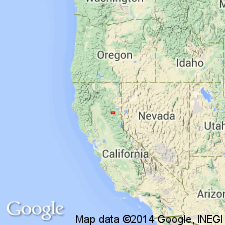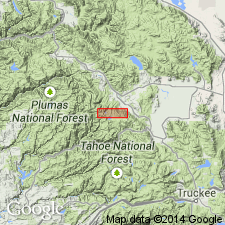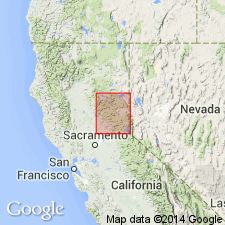
- Usage in publication:
-
- Goodhue Greenstone
- Modifications:
-
- Named
- Dominant lithology:
-
- Greenstone
- Basalt
- AAPG geologic province:
-
- Sierra Nevada province
Summary:
Name derived from Goodhue homestead on Ward Creek in NE/4 SW/4 SW/4 sec.14 T25N R11E, Kettle Rock 15' quad [Plumas Co, CA]. Building is shown on earlier topographic maps though not on latest (Kettle Rock, 1950). Type section designated in NE/4 sec.22 T25N R11E, Kettle Rock 15' quad [Plumas Co, CA]. Type locality includes east slope of Peale Ridge immediately west of Ward Creek. Name Goodhue Greenstone is applied to distinctive pyroclastic breccia which Diller (1908, USGS Bulletin 353) called Taylor Meta-Andesite and referred to as lavas. Goodhue (restricted to upper plate of Taylorsville thrust) overlies Peale Formation, whereas Taylor underlies Peale. Basalt of Goodhue contains augite plus relict second ferromagnesian phenocrysts now represented by magnesian chlorite or a serpentine mineral. Thickness is 1500 feet. Underlies Reeve Formation (of Permian age) and overlies Peale Formation (of Mississippian age). Goodhue is shown as probably Mississippian(?) age in explanation of block diagram.
Source: GNU records (USGS DDS-6; Menlo GNULEX).

- Usage in publication:
-
- Goodhue Formation
- Modifications:
-
- Redescribed
- Age modified
- Areal extent
- Overview
- AAPG geologic province:
-
- Sierra Nevada province
Summary:
Goodhue Greenstone of McMath (1966) is recognized in lower plate of Taylorsville thrust in Sierra City 15' quad and is redescribed as Goodhue Formation. Divided into three subunits. Report includes detailed lithology of subunits and discussion of fossil HELICOPRION SIERRENSIS and its significance as to age of unit. Goodhue Formation is possibly limited at its base within late Carboniferous and Early Permian age. Is limited at upper part by middle Permian age of overlying Reeve Formation.
Source: GNU records (USGS DDS-6; Menlo GNULEX).

- Usage in publication:
-
- Goodhue Formation*
- Modifications:
-
- Adopted
- Age modified
- Biostratigraphic dating
- AAPG geologic province:
-
- Sierra Nevada province
Summary:
McMath's (1966) Goodhue Greenstone [in Taylorsville area (kettle rock 15' quad)] and Goodhue Formation of Durrell and D'Allura (1977) [in Sierra City 15' quad] are here adopted as Goodhue Formation. Consists of porphyry breccia (flow rocks) and minor tuff. Overlies Peale and, locally, Arlington Formation; underlies Reeve Formation. Age is given as Early Permian (Leonardian and (or) early Guadalupian) based on fossils and stratigraphic relations.
Source: GNU records (USGS DDS-6; Menlo GNULEX).
For more information, please contact Nancy Stamm, Geologic Names Committee Secretary.
Asterisk (*) indicates published by U.S. Geological Survey authors.
"No current usage" (†) implies that a name has been abandoned or has fallen into disuse. Former usage and, if known, replacement name given in parentheses ( ).
Slash (/) indicates name conflicts with nomenclatural guidelines (CSN, 1933; ACSN, 1961, 1970; NACSN, 1983, 2005, 2021). May be explained within brackets ([ ]).

